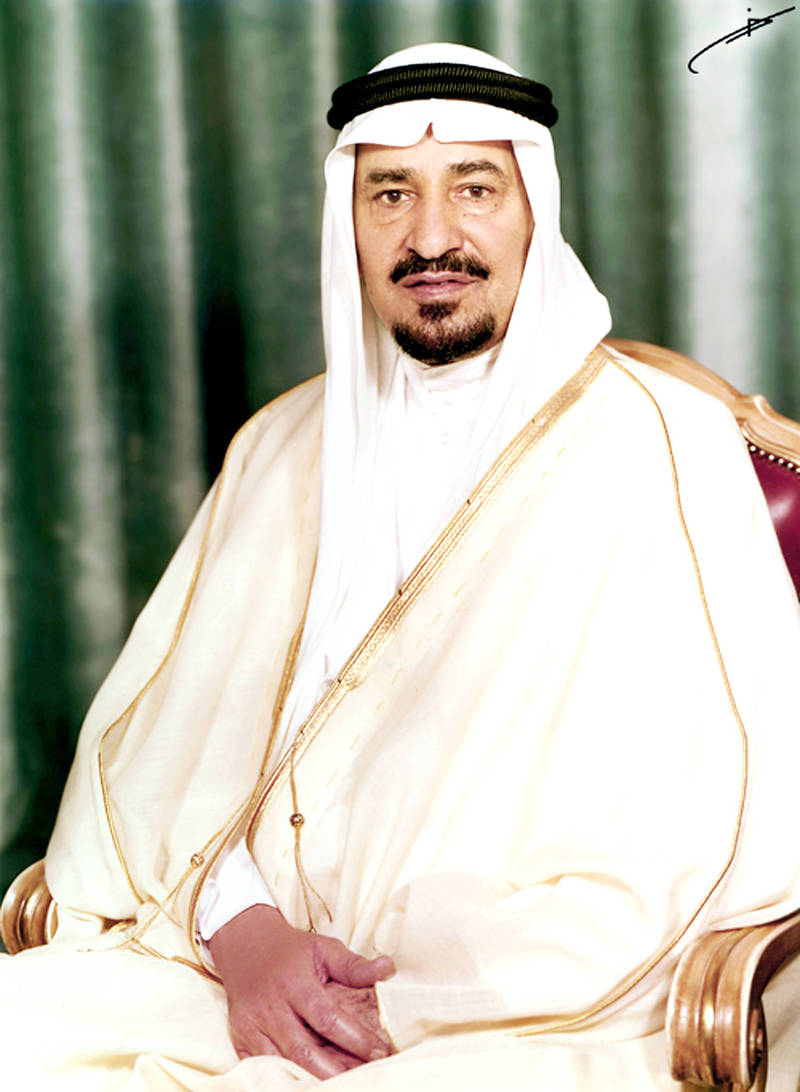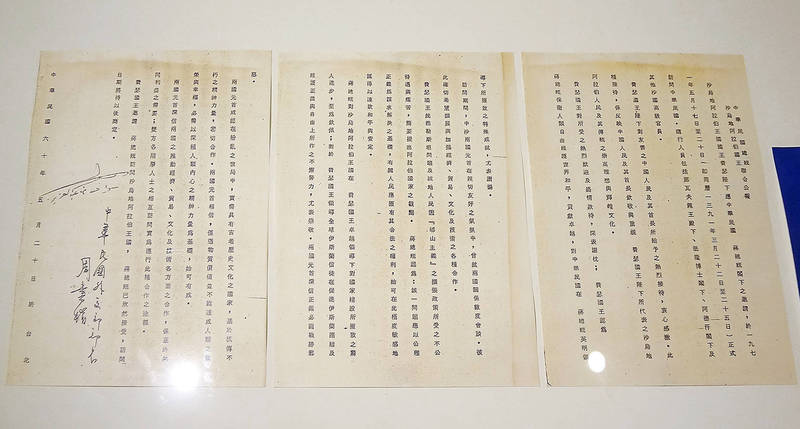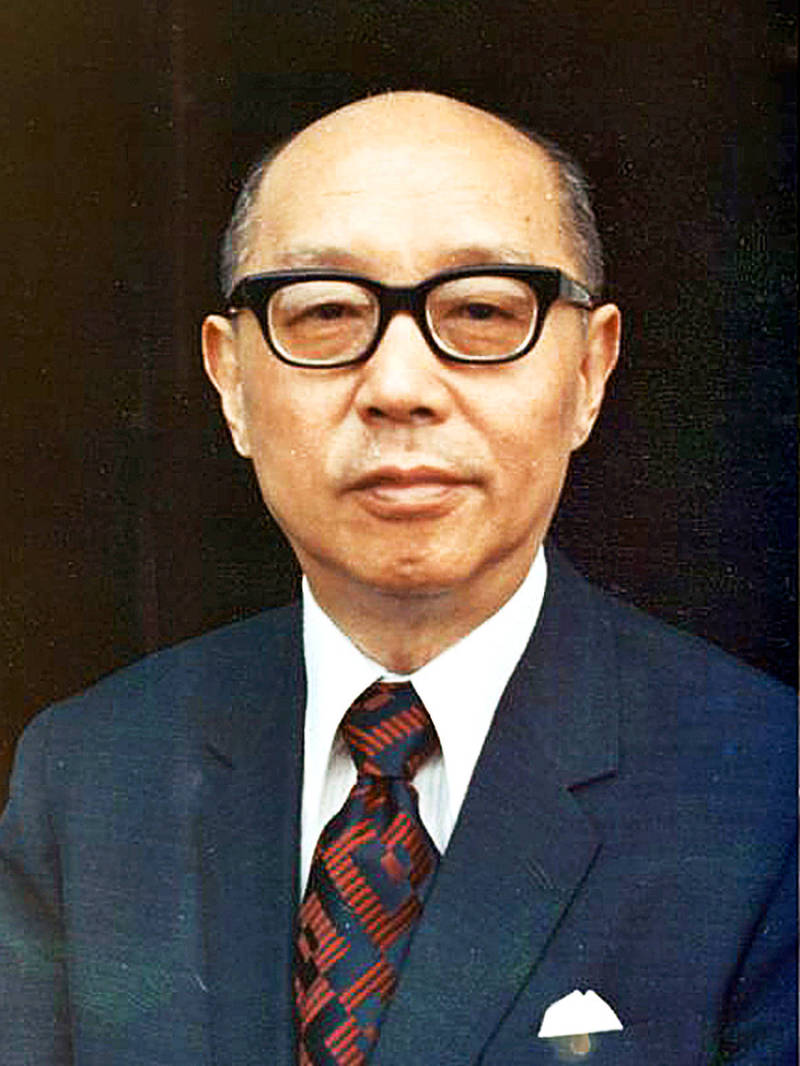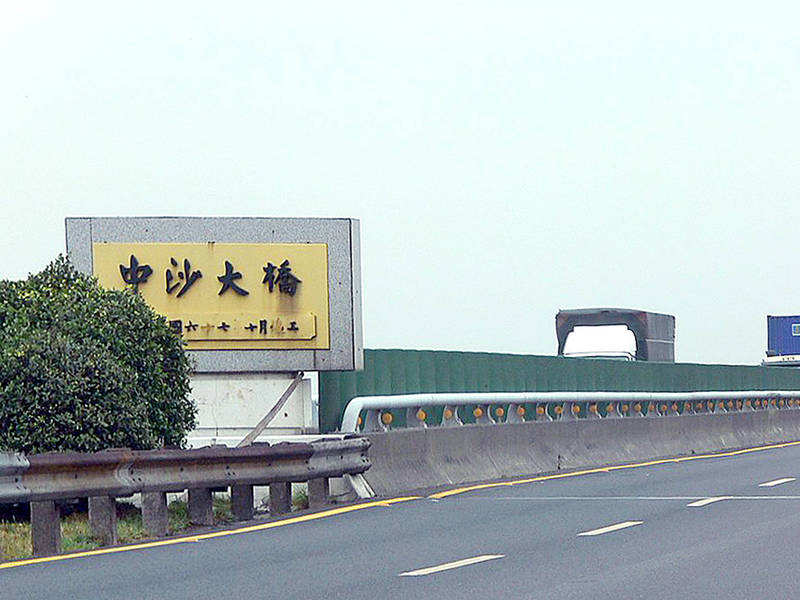《TAIPEI TIMES》 Taiwan in Time: The last great friend

The late King Khalid hosted former president Yen Chia-kan for three days in July 1977. Photo courtesy of Wikimedia Commons
Taiwan enjoyed exceptionally close ties with Saudia Arabia during the 1960s and 1970s, and the kingdom remained its most significant ally until 1990
By Han Cheung / Staff reporter
July 5 to July 11
Former president Yen Chia-kan (嚴家淦) made history when he boarded a Saudi Arabia-bound China Airlines jet on July 10, 1977. He became the first Chinese Nationalist Party (KMT)-era leader of Taiwan to visit a foreign country; his predecessor, Chiang Kai-shek (蔣介石), did not venture abroad after he retreated to Taiwan in 1949.
The press called Yen’s trip a “friendship mission” as he spent three days as the guest of the late King Khalid. The two countries became very close during the 1960s with numerous joint projects and exchanges, and Taiwan Today noted that “engineers and technicians from Taiwan have been helping the Saudi Arabians with their ambitious construction program. Saudi Arabia has backed the Republic of China internationally and supplied petroleum and loans for the Taiwan economy.”
Diplomatically, Saudia Arabia was the only Middle Eastern country to vote against China replacing Taiwan in the UN in 1971. And when Taiwan’s allies started dropping like flies in the next decade, Saudi Arabia became the last significant country to stick with the nation, notably rejecting China’s advances in 1975. But nothing could stop the political tide as the kingdom finally broke ties in 1990, eight years after King Khalid’s death.
Things were still rosy during Yen’s visit, however, as the two sides signed a joint communique at the conclusion of the trip, expressing their friendship and support of each other’s economic, cultural and political interests.
Yen reportedly returned home in good spirits: “Although he is 71 years old, President Yen returned to Taipei alert and with a reservoir of dynamic energy that put younger members of his party to shame,” Taiwan Today states.
CLOSE FRIENDS
The KMT established official relations with Saudi Arabia through a friendship treaty in 1946, but nothing concrete materialized as they were busy fighting the Chinese Civil War and recouping after their retreat to Taiwan.
In 1957, the KMT upgraded its consulate in Jeddah to an embassy. There was no Saudi embassy in Taipei, however; the role was handled by the kingdom’s ambassador to Japan.
The two countries were staunchly anti-communist, and Yen told Saudi media: “Both have opposed aggression, persecution and slavery in their anti-communist struggle.”
Former Muslim Chinese warlord Ma Bufang (馬步芳) was appointed ambassador to Jeddah. Ma had fled to Saudia Arabia after being routed by the People’s Liberation Army at the end of the Chinese Civil War and later moved to Cairo, where he served as KMT representative to Egypt until it severed ties with Taiwan in 1956.
The Saudi Arabian embassy was established in Taipei in 1968. King Faisal visited in 1971 and signed a joint communique with Chiang. Faisal invited Chiang to visit him, but both leaders died in 1975.
“Relations at first were largely those of protocol,” the Taiwan Today article states. But as Taiwan became more reliant on Saudi oil, exchanges became more frequent. They signed an agricultural cooperation agreement in 1965, and Taiwan sent a technical mission to Saudi Arabia that was still growing by 1977. Taiwan also helped the Saudis build power and fertilizer plants as well as highways.
Saudia Arabia provided a substantial interest-free loan to Taiwan to help it build the Sun Yat-sen Freeway (Freeway No 1), and the government named the bridge that spanned the Jhuoshuei River (濁水溪) Zhongsha Bridge (中沙大橋) in appreciation. The freeway’s inauguration ceremony was held in 1978 on this bridge, which, at 2,345m, was the longest in Taiwan at the time.
Yen’s visit was widely covered in the Saudi media, with one paper running a six-page special supplement on his trip. The two leaders exchanged awards — Yen presented Khalid with the Order of Brilliant Jade while he received the Collar of the Order of Abdul Aziz Al Saud. Both are honors reserved for heads of state.
“President Yen’s trip helped show that the Republic of China is not alone and friendless,” the Taiwan Today article concluded. “The hospitality of Saudi Arabia and the commitments of King Khalid contrasted dramatically with the coldness of others on the side of freedom who seemed to believe that the Communists could be appeased.”
DIPLOMATIC DRAMA
The China-Taiwan issue came to a head in the UN in 1971, when Albania submitted a resolution to admit China and expel Taiwan. The US offered a dual-representation proposal where both China and Taiwan would represent “China” in the UN, while Saudi Arabia suggested admitting China as China and Taiwan as Taiwan, adding that the people of Taiwan had the right to vote on whether to accept the situation.
It didn’t matter as the Albanian resolution was voted on first, with Saudia Arabia casting one of the 35 opposing votes. This led to a domino effect as Taiwan’s allies dropped from 68 to 31 between 1971 and 1973. In late 1977, the government learned that Jordan was about to ditch Taiwan for China, and immediately turned to neighboring Saudia Arabia for help. Then-ambassador Hsueh Yu-chi (薛毓麒) secured an audience with then-foreign minister Saud al-Faisal.
Unfortunately, the minister told Hsueh that Saudia Arabia had already dissuaded Jordan from making the move twice — King Faisal even personally spoke to Jordan’s King Hussein on the matter — but there was nothing they could do.
The study, Relations between the Republic of China and Saudi Arabia (中華民國與沙烏地阿拉伯王國雙邊關係之研究) by Su Hsin-wei (蘇信維) details how China eventually won the kingdom over.
China started permitting religious activity again in 1979 after the Cultural Revolution, and resumed sending yearly representatives on pilgrimage to Mecca that year. By 1986, this delegation boasted more than 3,000 members, helping boost Islamic exchange between the two nations.
China launched its commercial diplomacy initiative in 1985, and began a large-scale purchasing spree of Saudi Arabian goods over the next few years, including fertilizer, petrochemical products, wheat and air conditioners. By 1988, the two sides had established respective trade representative offices.
When the US temporarily stopped selling arms to Saudia Arabia in 1985 during the Iran-Iraq War, China swooped in and filled the void with favorable prices and substantial rebates.
During this time, China kept pushing for official recognition, and on July 10, 1990, Saudi ambassador to the US Bandar bin Sultan Al Saud flew to Beijing to meet with then-Chinese premier Li Peng (李鵬).
On July 18, 1990, a Saudi envoy arrived in Taipei and delivered the bad news to then-president Lee Teng-hui (李登輝), ending 44 years of official relations. It was far from the end, though, and unofficial relations resumed in January 1991 after lengthy negotiations.
Taiwan in Time, a column about Taiwan’s history that is published every Sunday, spotlights important or interesting events around the nation that either have anniversaries this week or are tied to current events.
新聞來源:TAIPEI TIMES

This photo shows the Chinese version of the joint communique signed by King Khalid and Yen Chia-kan on July 12, 1977. Photo courtesy of Wikimedia Commons

Yen Chia-kan became the first Chinese Nationalist Party-era president to visit a foreign country when he headed to Saudia Arabia in July 1977. Photo courtesy of Wikimedia Commons

The Zhongsha Bridge spanning Changhua and Yunlin counties is named in honor of Saudia Arabia, who helped fund its construction with an interest-free loan. Photo courtesy of Wikimedia Commons

















